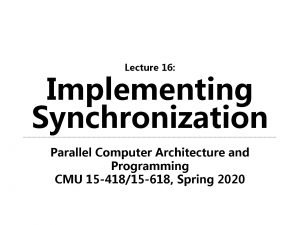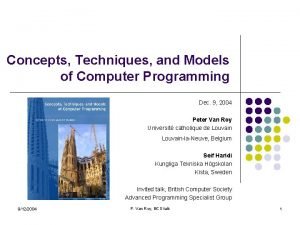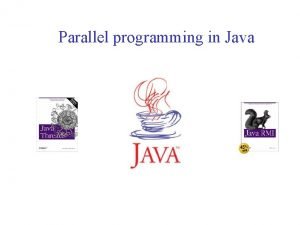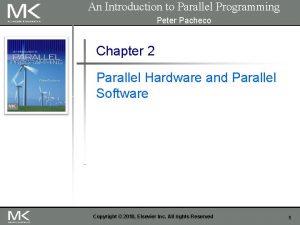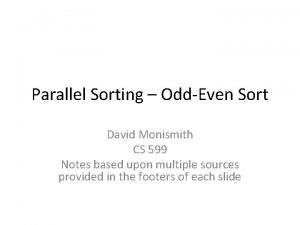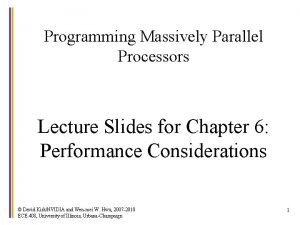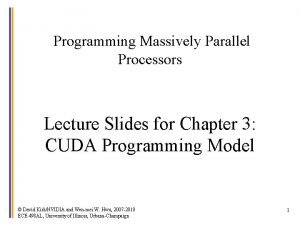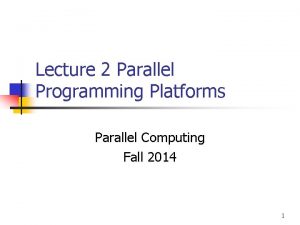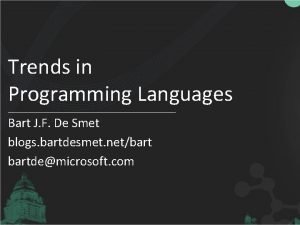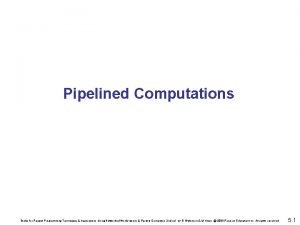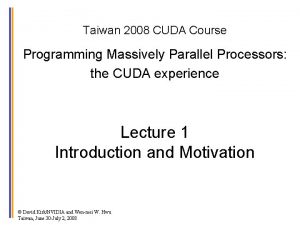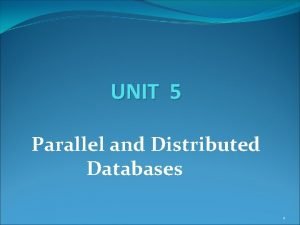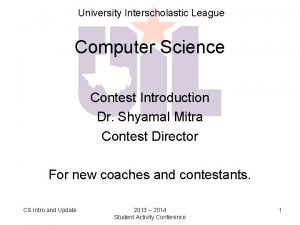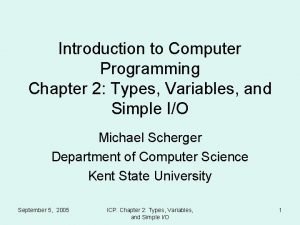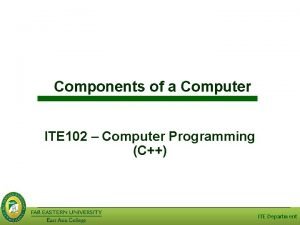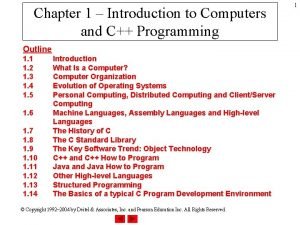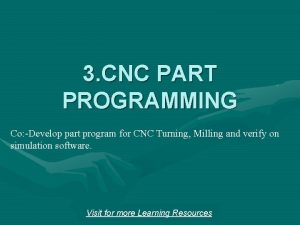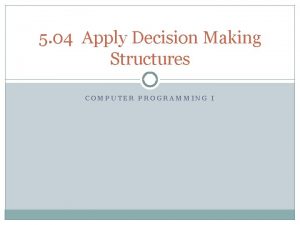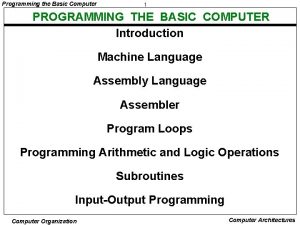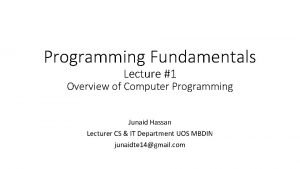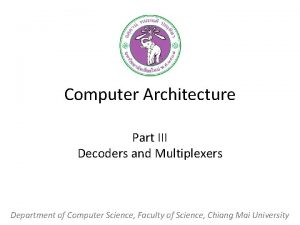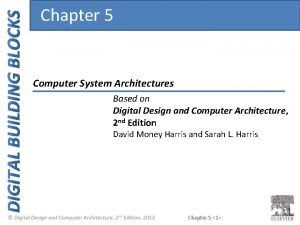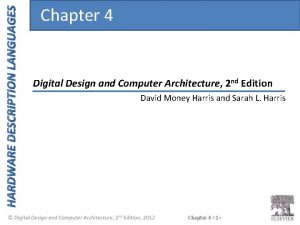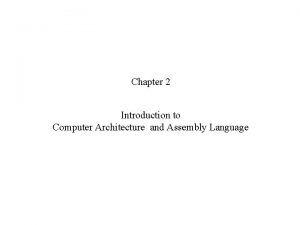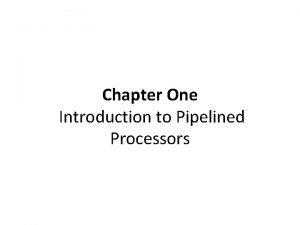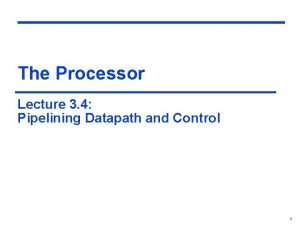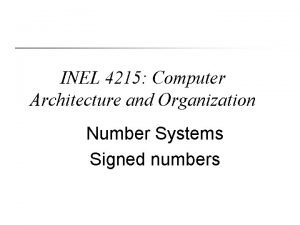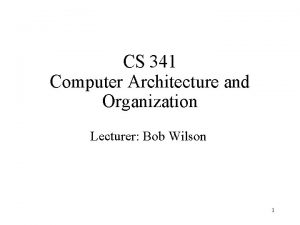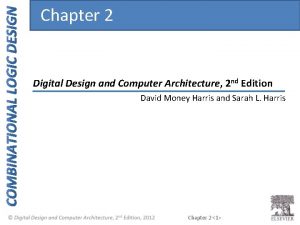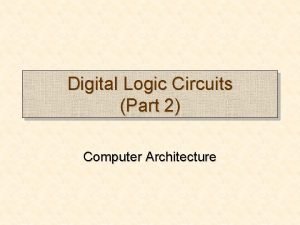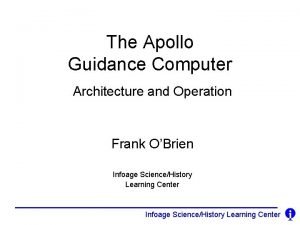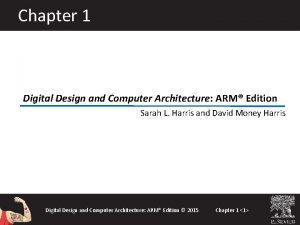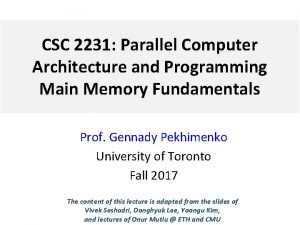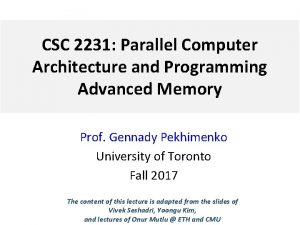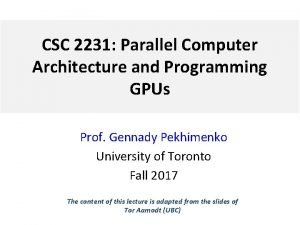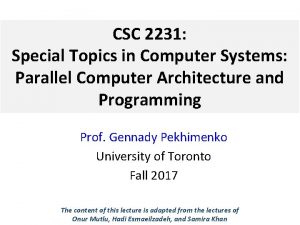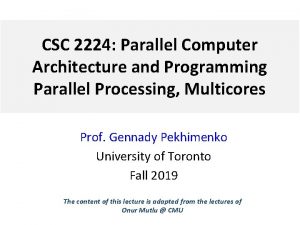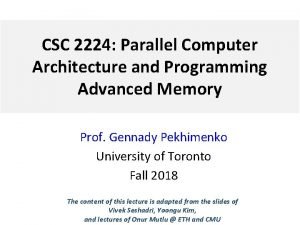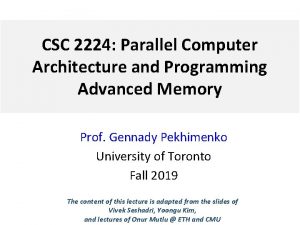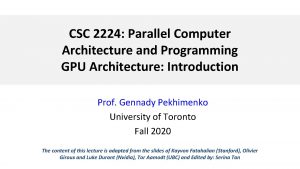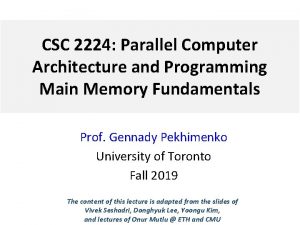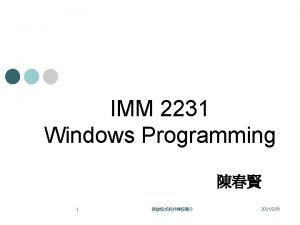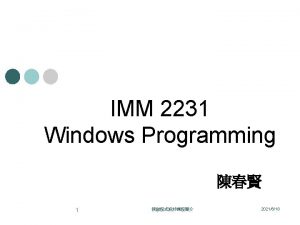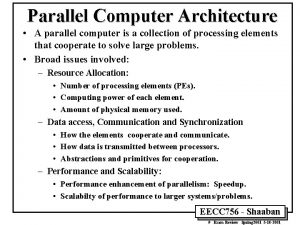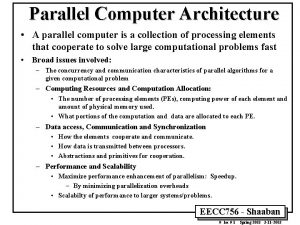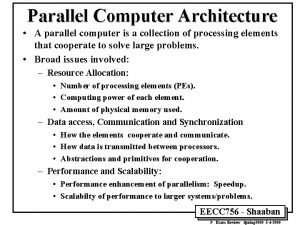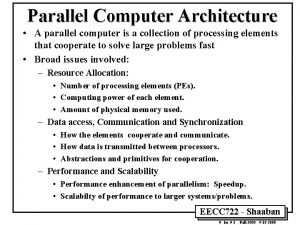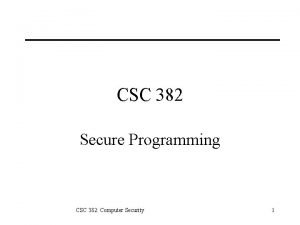CSC 2231 Parallel Computer Architecture and Programming Parallel












































































- Slides: 76

CSC 2231: Parallel Computer Architecture and Programming Parallel Processing, Multicores Prof. Gennady Pekhimenko University of Toronto Fall 2017 The content of this lecture is adapted from the lectures of Onur Mutlu @ CMU

Summary • Parallelism • Multiprocessing fundamentals • Amdahl’s Law • Why Multicores? – Alternatives – Examples 2

Flynn’s Taxonomy of Computers • Mike Flynn, “Very High-Speed Computing Systems, ” Proc. of IEEE, 1966 • SISD: Single instruction operates on single data element • SIMD: Single instruction operates on multiple data elements – Array processor – Vector processor • MISD: Multiple instructions operate on single data element – Closest form: systolic array processor, streaming processor • MIMD: Multiple instructions operate on multiple data elements (multiple instruction streams) – Multiprocessor – Multithreaded processor 3

Why Parallel Computers? • Parallelism: Doing multiple things at a time • Things: instructions, operations, tasks • Main Goal: Improve performance (Execution time or task throughput) • Execution time of a program governed by Amdahl’s Law • Other Goals – Reduce power consumption • (4 N units at freq F/4) consume less power than (N units at freq F) • Why? – Improve cost efficiency and scalability, reduce complexity • Harder to design a single unit that performs as well as N simpler units 4

Types of Parallelism & How to Exploit Them • Instruction Level Parallelism – Different instructions within a stream can be executed in parallel – Pipelining, out-of-order execution, speculative execution, VLIW – Dataflow • Data Parallelism – Different pieces of data can be operated on in parallel – SIMD: Vector processing, array processing – Systolic arrays, streaming processors • Task Level Parallelism – Different “tasks/threads” can be executed in parallel – Multithreading – Multiprocessing (multi-core) 5

Task-Level Parallelism • Partition a single problem into multiple related tasks (threads) – Explicitly: Parallel programming • Easy when tasks are natural in the problem • Difficult when natural task boundaries are unclear – Transparently/implicitly: Thread level speculation • Partition a single thread speculatively • Run many independent tasks (processes) together – Easy when there are many processes • Batch simulations, different users, cloud computing – Does not improve the performance of a single task 6

Multiprocessing Fundamentals 7

Multiprocessor Types • Loosely coupled multiprocessors – No shared global memory address space – Multicomputer network • Network-based multiprocessors – Usually programmed via message passing • Explicit calls (send, receive) for communication 8

Multiprocessor Types (2) • Tightly coupled multiprocessors – Shared global memory address space – Traditional multiprocessing: symmetric multiprocessing (SMP) • Existing multi-core processors, multithreaded processors – Programming model similar to uniprocessors (i. e. , multitasking uniprocessor) except • Operations on shared data require synchronization 9

Main Issues in Tightly-Coupled MP • Shared memory synchronization – Locks, atomic operations • Cache consistency – More commonly called cache coherence • Ordering of memory operations – What should the programmer expect the hardware to provide? • Resource sharing, contention, partitioning • Communication: Interconnection networks • Load imbalance 10

Metrics of Multiprocessors 11

Parallel Speedup Time to execute the program with 1 processor divided by Time to execute the program with N processors 12

Parallel Speedup Example • a 4 x 4 + a 3 x 3 + a 2 x 2 + a 1 x + a 0 • Assume each operation 1 cycle, no communication cost, each op can be executed in a different processor • How fast is this with a single processor? – Assume no pipelining or concurrent execution of instructions • How fast is this with 3 processors? 13

14

15

Speedup with 3 Processors 16

Revisiting the Single-Processor Algorithm Horner, “A new method of solving numerical equations of all orders, by continuous approximation, ” Philosophical Transactions of the Royal Society, 1819. 17

18

Takeaway • To calculate parallel speedup fairly you need to use the best known algorithm for each system with N processors • If not, you can get superlinear speedup 19

Superlinear Speedup • Can speedup be greater than P with P processing elements? • Consider: – Cache effects – Memory effects – Working set • Happens in two ways: – Unfair comparisons – Memory effects 20

Caveats of Parallelism (I) 22

Amdahl’s Law Amdahl, “Validity of the single processor approach to achieving large scale computing capabilities, ” AFIPS 1967. 23

Amdahl’s Law – f: Parallelizable fraction of a program – P: Number of processors 1 Speedup = 1 -f f P + • Maximum speedup limited by serial portion: Serial bottleneck 24

Amdahl’s Law Implication 1 25

Amdahl’s Law Implication 2 26

Why the Sequential Bottleneck? • Parallel machines have the sequential bottleneck • Main cause: Nonparallelizable operations on data (e. g. non-parallelizable loops) for ( i = 0 ; i < N; i++) A[i] = (A[i] + A[i-1]) / 2 • Single thread prepares data and spawns parallel tasks 27

Another Example of Sequential Bottleneck 28

Caveats of Parallelism (II) • Amdahl’s Law – f: Parallelizable fraction of a program – P: Number of processors 1 Speedup = 1 -f + f P • Parallel portion is usually not perfectly parallel – Synchronization overhead (e. g. , updates to shared data) – Load imbalance overhead (imperfect parallelization) – Resource sharing overhead (contention among N processors) 30

Bottlenecks in Parallel Portion • Synchronization: Operations manipulating shared data cannot be parallelized – Locks, mutual exclusion, barrier synchronization – Communication: Tasks may need values from each other • Load Imbalance: Parallel tasks may have different lengths – Due to imperfect parallelization or microarchitectural effects – Reduces speedup in parallel portion • Resource Contention: Parallel tasks can share hardware resources, delaying each other – Replicating all resources (e. g. , memory) expensive – Additional latency not present when each task runs alone 31

Difficulty in Parallel Programming • Little difficulty if parallelism is natural – “Embarrassingly parallel” applications – Multimedia, physical simulation, graphics – Large web servers, databases? • Big difficulty is in – Harder to parallelize algorithms – Getting parallel programs to work correctly – Optimizing performance in the presence of bottlenecks • Much of parallel computer architecture is about – Designing machines that overcome the sequential and parallel bottlenecks to achieve higher performance and efficiency – Making programmer’s job easier in writing correct and high-performance parallel programs 32

Parallel and Serial Bottlenecks • How do you alleviate some of the serial and parallel bottlenecks in a multi-core processor? • We will return to this question in future lectures • Reading list: – Annavaram et al. , “Mitigating Amdahl’s Law Through EPI Throttling, ” ISCA 2005. – Suleman et al. , “Accelerating Critical Section Execution with Asymmetric Multi-Core Architectures, ” ASPLOS 2009. – Joao et al. , “Bottleneck Identification and Scheduling in Multithreaded Applications, ” ASPLOS 2012. – Ipek et al. , “Core Fusion: Accommodating Software Diversity in Chip Multiprocessors, ” ISCA 2007. 33

Multicores 34

Moore’s Law Moore, “Cramming more components onto integrated circuits, ” Electronics, 1965. 35

36

Multi-Core • Idea: Put multiple processors on the same die • Technology scaling (Moore’s Law) enables more transistors to be placed on the same die area • What else could you do with the die area you dedicate to multiple processors? Have a bigger, more powerful core Have larger caches in the memory hierarchy Simultaneous multithreading Integrate platform components on chip (e. g. , network interface, memory controllers) 37 –… – –

Why Multi-Core? • Alternative: Bigger, more powerful single core – Larger superscalar issue width, larger instruction window, more execution units, large trace caches, large branch predictors, etc + Improves single-thread performance transparently to programmer, compiler 38

Why Multi-Core? • Alternative: Bigger, more powerful single core - Very difficult to design (Scalable algorithms for improving single-thread performance elusive) - Power hungry – many out-of-order execution structures consume significant power/area when scaled. Why? - Diminishing returns on performance - Does not significantly help memory-bound application performance (Scalable algorithms for this elusive) 39

Large Superscalar+Oo. O vs. Multi. Core • Olukotun et al. , “The Case for a Single-Chip Multiprocessor, ” ASPLOS 1996. 40

Multi-Core vs. Large Superscalar+Oo. O • Multi-core advantages + Simpler cores more power efficient, lower complexity, easier to design and replicate, higher frequency (shorter wires, smaller structures) + Higher system throughput on multiprogrammed workloads reduced context switches + Higher system performance in parallel applications 41

Multi-Core vs. Large Superscalar+Oo. O • Multi-core disadvantages - Requires parallel tasks/threads to improve performance (parallel programming) - Resource sharing can reduce single-thread performance - Shared hardware resources need to be managed - Number of pins limits data supply for increased demand 42

Comparison Points… 43

Why Multi-Core? • Alternative: Bigger caches + Improves single-thread performance transparently to programmer, compiler + Simple to design - Diminishing single-thread performance returns from cache size. Why? - Multiple levels complicate memory hierarchy 44

Cache vs. Core 45

Why Multi-Core? • Alternative: (Simultaneous) Multithreading + Exploits thread-level parallelism (just like multi-core) + Good single-thread performance with SMT + No need to have an entire core for another thread + Parallel performance aided by tight sharing of caches 46

Why Multi-Core? • Alternative: (Simultaneous) Multithreading - Scalability is limited: need bigger register files, larger issue width (and associated costs) to have many threads complex with many threads - Parallel performance limited by shared fetch bandwidth - Extensive resource sharing at the pipeline and memory system reduces both single-thread and parallel application performance 47

Why Multi-Core? • Alternative: Integrate platform components on chip instead + Speeds up many system functions (e. g. , network interface cards, Ethernet controller, memory controller, I/O controller) - Not all applications benefit (e. g. , CPU intensive code sections) 48

Why Multi-Core? • Alternative: Traditional symmetric multiprocessors + Smaller die size (for the same processing core) + More memory bandwidth (no pin bottleneck) + Fewer shared resources less contention between threads 49

Why Multi-Core? • Alternative: Traditional symmetric multiprocessors - Long latencies between cores (need to go off chip) shared data accesses limit performance parallel application scalability is limited - Worse resource efficiency due to less sharing worse power/energy efficiency 50

Why Multi-Core? • Other alternatives? – Clustering? – Dataflow? EDGE? – Vector processors (SIMD)? – Integrating DRAM on chip? – Reconfigurable logic? (general purpose? ) 51

Review next week • “Exploiting ILP, TLP, and DLP with the polymorphous TRIPS architecture”, K. Sankaralingam, ISCA 2003. 52

Summary: Multi-Core Alternatives • • Bigger, more powerful single core Bigger caches (Simultaneous) multithreading Integrate platform components on chip instead More scalable superscalar, out-of-order engines Traditional symmetric multiprocessors And more! 53

Multicore Examples 54

Multiple Cores on Chip • Simpler and lower power than a single large core • Large scale parallelism on chip Intel Core i 7 AMD Barcelona 8 cores IBM Cell BE IBM POWER 7 Intel SCC Tilera TILE Gx 8+1 cores 8 cores 4 cores Sun Niagara II 8 cores Nvidia Fermi 448 “cores” 55 48 cores, networked 100 cores, networked

With Multiple Cores on Chip • What we want: – N times the performance with N times the cores when we parallelize an application on N cores • What we get: – Amdahl’s Law (serial bottleneck) – Bottlenecks in the parallel portion 56

The Problem: Serialized Code Sections • Many parallel programs cannot be parallelized completely • Causes of serialized code sections – – Sequential portions (Amdahl’s “serial part”) Critical sections Barriers Limiter stages in pipelined programs • Serialized code sections – Reduce performance – Limit scalability – Waste energy 57

Demands in Different Code Sections • What we want: • In a serialized code section one powerful “large” core • In a parallel code section many wimpy “small” cores • These two conflict with each other: – If you have a single powerful core, you cannot have many cores – A small core is much more energy and area efficient than a large core 58

“Large” vs. “Small” Cores Large Core Out-of-order Wide fetch e. g. 4 -wide Deeper pipeline Aggressive branch predictor (e. g. hybrid) • Multiple functional units • Trace cache • Memory dependence speculation • • Small Core • • In-order Narrow Fetch e. g. 2 -wide Shallow pipeline Simple branch predictor (e. g. Gshare) • Few functional units Large Cores are power inefficient: e. g. , 2 x performance 59 for 4 x area (power)

Meet Small: Sun Niagara (Ultra. SPARC T 1) • Kongetira et al. , “Niagara: A 32 -Way Multithreaded SPARC Processor, ” IEEE Micro 2005. 60

Niagara Core • 4 -way fine-grain multithreaded, 6 -stage, dual-issue in-order • Round robin thread selection (unless cache miss) • Shared FP unit among cores 61

Niagara Design Point 62

Meet Small: Sun Niagara II (Ultra. SPARC T 2) • 8 SPARC cores, 8 threads/core. 8 stages. 16 KB I$ per Core. 8 KB D$ per Core. FP, Graphics, Crypto, units per Core. • 4 MB Shared L 2, 8 banks, 16 way set associative. • 4 dual-channel FBDIMM memory controllers. • X 8 PCI-Express @ 2. 5 Gb/s. • Two 10 G Ethernet ports @ 3. 125 Gb/s. 63

Meet Small, but Larger: Sun ROCK • Chaudhry et al. , “Simultaneous Speculative Threading: A Novel Pipeline Architecture Implemented in Sun's ROCK Processor, ” ISCA 2009 • Goals: – Maximize throughput when threads are available – Boost single-thread performance when threads are not available and on cache misses • Ideas: – Runahead on a cache miss ahead thread executes missindependent instructions, behind thread executes dependent instructions – Branch prediction (gshare) 64

Sun ROCK • 16 cores, 2 threads per core (fewer threads than Niagara 2) • 4 cores share a 32 KB instruction cache • 2 cores share a 32 KB data cache • 2 MB L 2 cache (smaller than Niagara 2) 65

More Powerful Cores in Sun ROCK 66

Meet Large: IBM POWER 4 • Tendler et al. , “POWER 4 system microarchitecture, ” IBM J R&D, 2002. • Another symmetric multi-core chip… • But, fewer and more powerful cores 67

IBM POWER 4 • • • 2 cores, out-of-order execution 100 -entry instruction window in each core 8 -wide instruction fetch, issue, execute Large, local+global hybrid branch predictor 1. 5 MB, 8 -way L 2 cache Aggressive stream based prefetching 68

IBM POWER 5 n Kalla et al. , “IBM Power 5 Chip: A Dual-Core Multithreaded Processor, ” IEEE Micro 2004. 69

Large, but Smaller: IBM POWER 6 • Le et al. , “IBM POWER 6 microarchitecture, ” IBM J R&D, 2007. • 2 cores, in order, high frequency (4. 7 GHz) • 8 wide fetch • Simultaneous multithreading in each core • Runahead execution in each core – Similar to Sun ROCK 70

Many More… • Wimpy nodes: Tilera • Asymmetric multicores • DVFS 71

Computer Architecture Today • Today is a very exciting time to study computer architecture • Industry is in a large paradigm shift (to multi-core, hardware acceleration and beyond) – many different potential system designs possible • Many difficult problems caused by the shift – – – Power/energy constraints multi-core? , accelerators? Complexity of design multi-core? Difficulties in technology scaling new technologies? Memory wall/gap Reliability wall/issues Programmability wall/problem single-core? 72

Computer Architecture Today (2) • These problems affect all parts of the computing stack – if we do not change the way we design systems Problem Algorithm Program/Language Runtime System (VM, OS, MM) ISA Microarchitecture Logic Circuits Electrons 73 User

Computer Architecture Today (3) • You can revolutionize the way computers are built, if you understand both the hardware and the software • You can invent new paradigms for computation, communication, and storage • Recommended book: Kuhn, “The Structure of Scientific Revolutions” (1962) – Pre-paradigm science: no clear consensus in the field – Normal science: dominant theory used to explain things (business as usual); exceptions considered anomalies – Revolutionary science: underlying assumptions re-examined 74

… but, first … • Let’s understand the fundamentals… • You can change the world only if you understand it well enough… – Especially the past and present dominant paradigms – And, their advantages and shortcomings -- tradeoffs 75

CSC 2231: Parallel Computer Architecture and Programming Parallel Processing, Multicores Prof. Gennady Pekhimenko University of Toronto Fall 2017 The content of this lecture is adapted from the lectures of Onur Mutlu @ CMU

Asymmetric Multi-Core 77

Asymmetric Chip Multiprocessor (ACMP) Large core “Tile-Large” Small core Small core Small core Small core Small core “Tile-Small” Small core Small core Small core Large core ACMP • Provide one large core and many small cores + Accelerate serial part using the large core (2 units) + Execute parallel part on small cores and large core for high throughput (12+2 units) 78
 Cse 2231
Cse 2231 What is nano programming
What is nano programming Difference between architecture and organisation
Difference between architecture and organisation Bus architecture in computer organization
Bus architecture in computer organization Parallel computer architecture cmu
Parallel computer architecture cmu Sequential interrupt processing
Sequential interrupt processing Basic computer organisation and design
Basic computer organisation and design Perbedaan linear programming dan integer programming
Perbedaan linear programming dan integer programming Greedy algorithm vs dynamic programming
Greedy algorithm vs dynamic programming Components of system programming
Components of system programming Linear vs integer programming
Linear vs integer programming Definisi linear
Definisi linear Concepts techniques and models of computer programming
Concepts techniques and models of computer programming Linear programming models: graphical and computer methods
Linear programming models: graphical and computer methods Return architecture
Return architecture Programming massively parallel processors
Programming massively parallel processors Parallel programming patterns
Parallel programming patterns Parallel programming java
Parallel programming java An introduction to parallel programming peter pacheco
An introduction to parallel programming peter pacheco Bubble sort mpi
Bubble sort mpi Mpi parallel programming in c
Mpi parallel programming in c Programming massively parallel processors
Programming massively parallel processors Programming massively parallel processors
Programming massively parallel processors Parallel programming platforms
Parallel programming platforms F# parallel programming
F# parallel programming Parallel programming
Parallel programming Programming massively parallel processors, kirk et al.
Programming massively parallel processors, kirk et al. Parallel and distributed database architecture
Parallel and distributed database architecture Parallel and distributed database architecture
Parallel and distributed database architecture Nocti computer programming study guide
Nocti computer programming study guide Language
Language American computer science league practice problems
American computer science league practice problems Types of variables in computer programming
Types of variables in computer programming Programming raster display system in computer graphics
Programming raster display system in computer graphics Components of computer programming
Components of computer programming Computer programming chapter 1
Computer programming chapter 1 Define part program
Define part program Discrete mathematics with applications fourth edition
Discrete mathematics with applications fourth edition Computer programming chapter 1
Computer programming chapter 1 History of python
History of python Computer programming with matlab
Computer programming with matlab Decision making in computer programming
Decision making in computer programming Computer organization
Computer organization Programming fundamentals 1
Programming fundamentals 1 Python programming an introduction to computer science
Python programming an introduction to computer science Computer organization and architecture 10th solution
Computer organization and architecture 10th solution Virtual labs iit kharagpur
Virtual labs iit kharagpur Introduction to computer organization and architecture
Introduction to computer organization and architecture Timing and control in computer architecture
Timing and control in computer architecture Evolution of computer architecture
Evolution of computer architecture Digital design and computer architecture arm edition
Digital design and computer architecture arm edition Spec rating formula in computer organization
Spec rating formula in computer organization Computer organization and architecture 10th edition
Computer organization and architecture 10th edition Non linear pipeline processor
Non linear pipeline processor Digital design and computer architecture
Digital design and computer architecture Multiplexer in computer organization
Multiplexer in computer organization Digital design and computer architecture
Digital design and computer architecture Digital design and computer architecture
Digital design and computer architecture Assembly language and computer architecture
Assembly language and computer architecture Computer organization and architecture stallings
Computer organization and architecture stallings Computer organisation and architecture
Computer organisation and architecture Hazard detection and resolution
Hazard detection and resolution Mips pipeline datapath
Mips pipeline datapath 1s complement
1s complement Computer architecture and organization
Computer architecture and organization Digital design and computer architecture
Digital design and computer architecture Digital logic and computer architecture
Digital logic and computer architecture The apollo guidance computer: architecture and operation
The apollo guidance computer: architecture and operation Digital design and computer architecture arm edition
Digital design and computer architecture arm edition Resultant of parallel forces example problems
Resultant of parallel forces example problems Parallelism rules
Parallelism rules Non parallel sentence
Non parallel sentence Parallel structure means
Parallel structure means Parallel and not parallel in english
Parallel and not parallel in english Difference between a computer and computer system
Difference between a computer and computer system What is computer organization
What is computer organization Output devices drawing
Output devices drawing




